1. Maximising return on investment (ROI)
We’ll start by focusing on how you can increase your ROI. Within this section we’ll cover the following:
- Lowering cost per acquisition by using SEO optimisations to improve the quality score of your ads
- Generating budget efficiencies by turning off ads for keywords where you’re already winning at SEO
- Protecting revenue by teaming up across channels to monitor site health
- Targeting keywords that convert in SEO by mining the keyword insights available in AdWords
- Increasing click-through-rate by writing better meta data
- Crafting hyper-targeted PPC campaigns by creating audiences from GA segments
1.1 Lowering cost per acquisition
Did you know that your SEO optimisations directly impact how much you have to pay for your PPC ads? This is because landing page experience is a key component of quality score, a metric used by Google to determine the suitability of your ads for your chosen keyword set.
As Google is always striving to provide the best user experience possible, it rewards strong quality scores with higher ad positions and lower cost-per-clicks (CPCs).

Above: the various components that affect how much advertisers pay for a click on their ads
‘Landing page experience’ could be measured in a multitude of ways, yet Google has thankfully provided a very clear breakdown in their official documentation of exactly what to focus on in order to excel in this area. In addition to recommending that site owners strive to improve conversion rates, as it’s a “proxy for good landing page experience”, Google also suggests the following:
| Google Recommendation | SEO Translation |
| “Give people what they’re looking for” | Answer user intent |
| “Keep messaging consistent from ad to landing page” | Have relevant on-page keyword optimisation |
| “Improve loading speed” | Optimise for Core Web Vitals |
| “Make your website mobile friendly” | Ensure your pages are well-designed for mobile |
As the table shows, optimising your site from an SEO standpoint naturally translates into a better landing page experience, which not only has the added benefit of improving the experience of your users, but it also makes your ads cheaper too. A win-win all round!
1.2 Generating budget efficiencies
Here at Builtvisible we understand that when organic and paid search work together instead of independently, performance efficiencies can be unlocked, thus providing a greater return on marketing spend. One of the ways we help clients achieve this is by conducting a PPC and SEO cost analysis project. This is where we analyse keyword performance across both channels in order to identify where cross-channel efficiencies can be made.
For example, for a food takeaway brand we discovered they had spent nearly £80,000 in three months bidding on keywords where they already ranked in position one in the organic search results. This spend could have been more effective in areas where they didn’t occupy position one of organic search, or could have even been moved to another digital channel altogether.
It’s always important to first carry out tests when optimising for cross-channel efficiencies, in order to mitigate any risks. Below are some scenarios you may like to try.
Scenario 1: pause bidding on brand keywords

Bidding on brand keywords is very commonplace, and for good reason. If competitors are bidding on your brand, you’ll want to keep your ads running as a form of brand defence. However, if competitors aren’t bidding on your brand name, it’s definitely worth testing turning off your brand PPC campaigns and funnelling this spend elsewhere.
As you run the experiment, you’ll want to make sure that your organic results are indeed absorbing the traffic that was originally clicking on your ads, as well as keeping an eye out for any competitors that might see this as an opportunity to start bidding on your terms.
In the case of Vitality (below), turning off brand ads could be something they might want to try. There are no competitors bidding on their brand, and on top of this their SEO and PPC results are very similar:
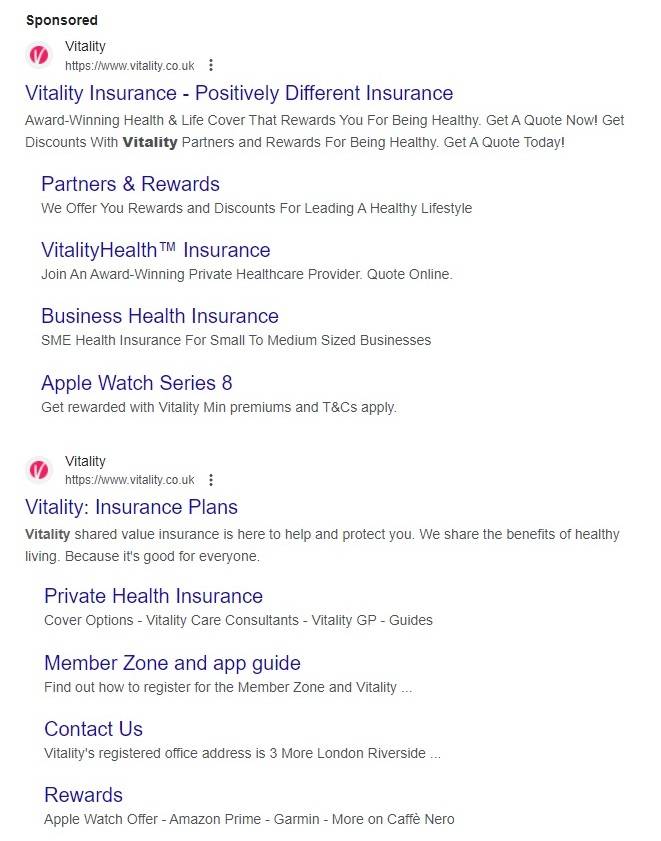
Scenario 2: pause bidding on non-brand keywords

A second scenario to try would be to pause bidding on keywords where you rank in top position in the organic results and no competitors are bidding. It’s definitely worth seeing if some budget can be repurposed here. The opportunities here will likely sit on the longer-tail end of the keyword spectrum.
As with the other test, you’ll need to make sure your organic result is indeed absorbing the traffic that was originally going to your PPC ads. Again, regular monitoring would be required in case competitors spot this opportunity to start bidding.
Another important consideration before running this test is also making sure that the SEO page that’s ranking is either the same as your PPC landing page, or has an equal or better conversion rate. This is to ensure that even if total traffic doesn’t decrease, conversion rate doesn’t either.
And finally, a position one ranking in SEO no longer guarantees appearing at the top of the search results, or even above the fold. Make sure that search features such as the map pack aren’t pushing your number one organic position too far down the page. If that’s the case, you might want to consider keeping your PPC ads running so you don’t lose your spot at the top of the search results.
Taking this into account, we might therefore want to revise the test conditions above to the following:

1.3 Protecting site health
Good site health is incredibly important for a multitude of reasons, all of which ultimately boil down to revenue.
First and foremost, if your site doesn’t work properly it creates a very frustrating experience for users. The immediate impact of this is reduced conversion rates, however it also negatively affects brand perception, the ramifications of which can be long-lasting. Therefore this needs to be avoided at all costs.
From an SEO standpoint, poor site health means that Google doesn’t consider your website to be of high quality, which negatively impacts rankings. So traffic to your site suffers as a result.
And finally for PPC, it means damage to your PPC quality score, which means your CPCs are higher and you have to pay more for the same amount of traffic.
Proactively monitoring site health is therefore of primary importance. Fortunately, both channels have methods and tools that can be shared between teams to keep on top of any tech issues as and when they arise. More eyes on site health ultimately means greater revenue protection!
In PPC, there are Google Ads Scripts that can be easily set up to monitor the status codes of your landing pages, as well as highlight any issues with page speed. You can simply add both your PPC and SEO team to the alerts by inputting their email addresses into the script configuration. Note that the maximum cadence of the status code check is daily, while the page speed script can be configured to run hourly.
On the SEO side, you can use tools such as Content King to crawl your entire site 24/7, flagging a whole host of issues in real-time. This includes changes to the page <h1>, which could affect your PPC quality score if it no longer contains keywords relevant to your PPC campaign. With this tool you can create segments too, so it’s easy to group your PPC landing pages in the platform to more easily keep a closer eye on them.
With such comprehensive monitoring, PPC ads can be paused in a flash if pages go down, protecting your revenue, quality score and user experience. In addition, issues with site speed can be caught early and passed onto your dev team to be investigated and fixed.
1.4 Adjusting your SEO keyword targeting strategy
Despite all the technological advancements over the years, there’s no denying that keywords continue to be the bedrock of both SEO and PPC channels.
Use this to your advantage by sharing your keyword research between teams. This is a simple time-saving exercise and avoids duplication of effort. This in itself is a quick win in a world where time equals money!
In addition, Google Ads contains levels of data that an SEO team can only dream of. Commercial data such as keyword competition, conversion rates and revenue figures can be used by SEO teams to adjust keyword-targeting strategies in order to focus on driving revenue over traffic. For example, it could make sense for your SEO team to test re-optimising pages in order to target keywords that have lower search volumes but which convert much more effectively.
1.5 Increasing click-through-rate by writing better meta data
In a similar vein to the above, SEO teams can also make the most of PPC data by incorporating the top-performing ad copy into SEO titles and meta descriptions. Additionally, new ideas for meta data can first be trialled via PPC campaigns to make sure they’ll have maximum impact on click-through-rate. This means more traffic, and more revenue, for the same ranking positions.
This is such a fundamental and often missed opportunity for SEO teams to take advantage of. With so many factors at play in SEO, it’s very difficult to tie any click-through rate changes back to your carefully crafted meta data.
Yet in AdWords, Google not only allows you to run ad copy tests, but encourages you to do so. These tests contain statistical significance thresholds so that you can be confident that the winning ad copy really is attracting more clicks due to the way it’s written, and not due to other factors such as ranking position or simple chance.
1.6 Crafting hyper-targeted PPC campaigns by creating audiences from GA segments
With PPC campaigns, it’s possible to be very specific with who you display your ads to thanks to audience targeting. SEO can support your PPC efforts here by helping create relevant segments in your analytics platform, which can be then used as audiences for PPC activity.
For example, if you’re a motoring website, you could create an electrical vehicle content hub as part of your SEO efforts. A GA segment could then be created that contains users who have shown a strong interest in this content, whether through several page views or landing on this content via organic search. This segment could then be used to create an audience to display electrical vehicle ads to. The return on investment here should be much stronger, as you’d be able to display highly relevant ads to a very targeted audience.
2. Reaching more customers
PPC and SEO really complement each other when it comes to increasing reach. There are several ways that both channels can be used in tandem to put your brand in front of more potential customers. The areas we’re going to cover are the following:
- Reaching customers at all stages of the buying journey
- Increasing visibility in the search results
- Getting in front of customers fast
- Generating new content ideas
2.1 Reaching customers at all stages of the buying journey
PPC is predominantly a bottom-of-funnel activity, however SEO can be used to complement your PPC activities by reaching and influencing users at all stages of the buying journey. The benefits of this are numerous.
First of all, creating great quality SEO content that puts your brand in front of users when they’re higher in the conversion funnel gives you a competitive edge. This is because it allows you to influence user behaviour at the very top of the funnel instead of just competing at the bottom where the search results are most competitive. The end result is that you manufacture branded search volume and direct traffic to your site instead of competing in the mainstream market. This not only increases your customer base but also lowers your cost per acquisition.
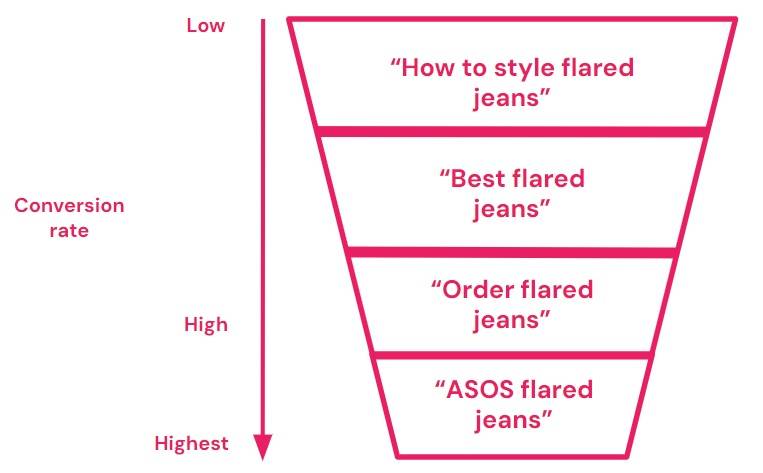
Above: reaching users at the top of the funnel means they’re more likely to think of your brand when they come to purchase. This results in increased demand for your brand, as well as higher conversion rates.
Secondly, top-of-funnel content enables you to nurture your customers along the journey to conversion by building trust. You can do this by comprehensively answering their questions, alleviating any of their concerns and allowing them to get to know your brand. This is especially important for products that have a long consideration phase, such as B2B products or high-ticket items.
Finally, if your product offering is particularly complex, comprehensive content aimed at education allows you to help customers understand what you offer and how you can help them.
This is also applicable if your product is new, for example if you’re a start-up breaking into a new market. PPC is rarely an option in this instance because search demand is so low. Instead, top-of-funnel content is the key to reach those users who have a problem you can solve, but who don’t know how to search for the solution, or that it even exists yet.
Even if PPC is an option for your start-up, in order to hit those high growth targets set by your investors it’s key to diversify into other channels. This helps you to avoid stagnating. We discuss how SEO can help with this in more detail here.
2.2 Increasing visibility in the search results
When it comes to dominating the search results, both channels need to be utilised to maximum effect. This is not simply to enable your brand to take up more real estate in the search results, although of course that is one key outcome. There are other benefits to both channels working together to achieve more visibility.
2.2.1 Appear for queries that would be impossible with organic alone
First of all, PPC can enable your brand to appear for search queries that would simply be impossible to appear for in the organic results. An example here is queries where aggregator sites dominate the organic results. SaaS products and hotels are two examples that come to mind where this is frequently an issue.
In the example below, Viva Skin Clinics is ranking at the very top of the search results for ‘spa london’ with a paid ad. This is notable because ranking in the organic listings for this query would simply be impossible for this brand, as every single organic result is an aggregator site (such as Time Out, Harper’s Bazaar and CN Traveller). Their PPC efforts are really paying off here and adding a strong boost to their visibility.

2.2.2 Satisfy multiple intents at once
Another benefit to utilising both SEO and PPC for your marketing efforts is that you can satisfy a range of intents within a single search. For example, depending on the query you could have a PPC ad that’s highly commercial, targeting users at the bottom of the funnel, and an SEO result that’s informational, targeting users who are still in the research phase.
A good example of this in practice is Zoho, who are ranking for ‘crm software’ with both a PPC ad and an SEO result. This is not unusual, however what makes this approach notable is that their PPC ad targets a completely different audience to their SEO result:

Their ad sends users to a free trial lead-capture page and their sitelink extensions are heavily conversion-focused with a demo page, another lead-capture page and a product comparison page. Meanwhile their SEO result is all about educating users as to what a CRM actually is. The benefits here are that they’re able to capture users across the spectrum of intents and don’t miss out by only catering to a subset of searchers. This also links to the point above regarding the importance of catering to all stages of the funnel.
2.2.3 Beat competitors to the top spot
In an earlier section above we discussed some tests you might want to run in order to create budget savings. There are further tests you might like to try in a bid to increase revenue.
If there are commercial keywords for which you’re not ranking top, and no competitors are bidding, it could be worth starting to bid on these keywords. With no competition, cost-per-click should be reasonably low and being the only ad appearing, you’d expect your click-through rate to be decent.
Continuing in a similar vein as before, see the diagram below which sets out the conditions for this test.
Scenario 3: start bidding on non-brand keywords

You may wonder why competitors wouldn’t already be bidding on keywords that are truly valuable. For sure it’s rare, but it does happen (see the example below). You’ll find these opportunities sitting at the longer-tail end of the spectrum, which ironically makes them even more valuable, so why no-one would be bidding here is even more astonishing.
In the screenshot below, we have organic results for the keyword “ford fiesta zetec s 1.0 ecoboost”. For those not familiar with cars, this is a search for a specific trim (ford fiesta zetec s) with the engine (1.0 ecoboost) also specified. This query is gold dust: it receives 1,000 searches every month and has very strong commercial intent. How do we know? The specificity of the query shows us that users know exactly what they’re looking for, and are therefore very close to converting.
Yet amazingly, no-one is bidding on this query:

It wouldn’t necessarily be a good use of budget for Parkers, who currently rank top organically and are appearing at the top of the page, to start bidding on this query. However, results further down such as Motors, Auto Trader and other brands would absolutely benefit from starting to run ads here. In a flash, they’d take the top spot of the search results for minimal cost with a potentially huge pay-off.
2.2.4 Appear across the whole search results page
Finally, with search features becoming increasingly prominent, it’s becoming more and more difficult to appear above-the-fold, even with an organic number one ranking position. With the upcoming release of Google’s generative AI experience for search, this is only going to get more challenging. You can use PPC to appear at the top of the page (for now at least), while with SEO you can optimise for SERP features such as map pack, people also ask, and featured snippets to increase coverage elsewhere in the search results.
2.3 Getting in front of customers fast
SEO requires a long-term commitment. It can take weeks or even months to gain momentum in this channel and to reap the rewards of your hard work.
PPC, on the other hand, is wonderfully quick. You can get to the top of page one in a heartbeat, without needing to wait weeks or months to acquire the authority needed to rank well. In fact, it can take just one day (or less!) for a new ad campaign to go live, and in as little as three months it can be fully optimised and generating a strong return on investment. This allows brands to be super fast and reactive when they need to be, such as with new product launches or time-sensitive campaigns.
Of course in SEO, not only does it take time for pages to build authority, but the other downside is that you’re also at the mercy of dev queues, algorithm updates and SERP changes. Performance has the potential to be quite unpredictable as a result. Therefore another benefit to running ads is that performance can be more reliable as there are fewer factors at play. There’s varying competition and seasonality, but other factors such as quality score and campaign optimisation are far more under our control as marketers.
The downside is that you lose this visibility in PPC as soon as you stop bidding, and of course running PPC ads can be quite costly compared to executing an SEO strategy. However, when both channels are used in a complementary manner, they can offset each other’s weaknesses so that you get the best of both worlds.
2.4 Generating new keyword ideas
Earlier we touched on the incredible amount of data that PPC teams have at their fingertips when it comes to keyword performance, and how SEO teams can use this to adjust the optimisation of existing pages on the site.
Another opportunity that SEO teams can take advantage of is mining PPC search terms reports to identify new landing page opportunities. These reports list out all the queries users typed into Google that triggered your ads to appear. The additional advantage here is that of course there’s conversion data to verify the validity of these queries, and can help SEO teams make the decision as to whether the keyword is worth creating a dedicated page for or not.
An additional upside to this is that by building out landing pages targeted to those specific queries, it improves PPC quality score as these queries now have highly relevant dedicated pages that can be used in paid campaigns.
3. Influencing brand perception
In SEO, we have very little control over how our brand appears in the search results. From title tags being re-written to sitelinks being selected seemingly at random, in SEO we’re at the mercy of Google’s preferences.
However in PPC, we have much more control over how our brand is displayed. This has the following benefits, which we’ll explore in this section:
- Controlling your brand messaging
- Turbocharging time-sensitive campaigns
- Outsmarting your competitors
- Protecting your brand’s reputation
3.1 Controlling your brand messaging
Our performance director Dan Butler has described SEOs as ‘veterans of change’, given that really the only constant in our industry is change. From algorithm updates to new search results features, there is always change afoot.
Even at the most basic level, something as simple as title tags or meta descriptions can be out of our control, with Google re-writing 60% of titles and 70% of meta descriptions. This can be somewhat disheartening if you’ve taken the time and effort to carefully craft these, not only including strong keyword optimisation but also creating enticing copy that’s aligned with your brand tone of voice.
In PPC, there’s no such problem. Your ad copy isn’t replaced or tweaked by an algorithm, it appears exactly as you’ve specified (well, mostly – with responsive search ads you provide multiple headlines and descriptions and then AdWords combines these for maximum effect). This greater creative control allows you to present your brand as you wish, with minimal modifications to your messaging by Google.
Another benefit is the use of sitelinks, the appearance of which we can only influence in SEO (thanks Google), while in PPC these can be specified as part of your ad extensions.
In short, PPC is a far more reliable channel for presenting the brand image that you want to show customers in search results. On top of this, you can specify exactly which URLs to send users to, which we can only hope to influence in SEO.
3.2 Turbocharging time-sensitive campaigns
As we discussed above, it takes time for your SEO campaigns to gain momentum. When dealing with time-sensitive campaigns that require immediate visibility, SEO is at a real disadvantage. This is where PPC really comes into its own.
For example, at the time of writing this, Timberland is running an end-of-season summer sale. They’re able to promote this heavily in their PPC result, which is fortunate as their SEO result is only displaying a single sitelink relevant to the sale.
In addition, the PPC ad copy is able to promote the 50% discount, which is far more enticing for users (using numbers in copy is well-known to be effective at increasing click-through rate) while the SEO result is far less captivating:
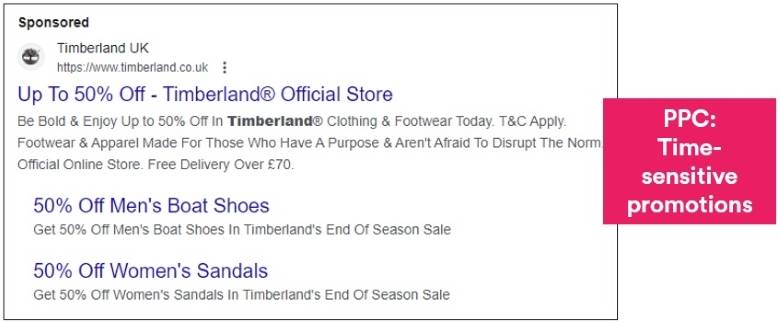
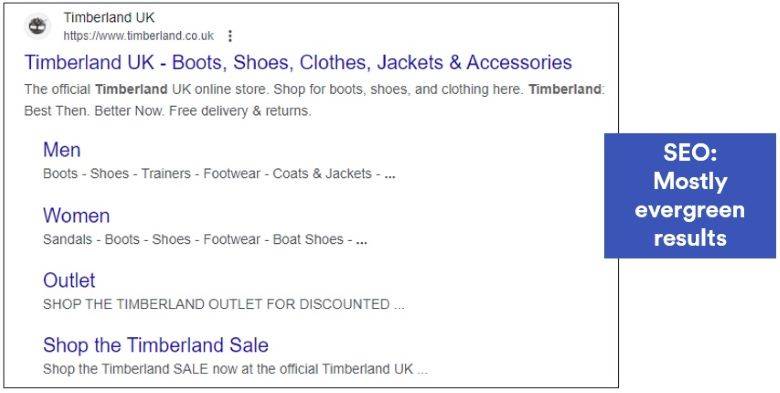
Sale periods aren’t the only times when brands have time-sensitive campaigns to run. In the example below, IBM highlighted their Wimbledon partnership in one of their PPC sitelinks during the two-week tournament:
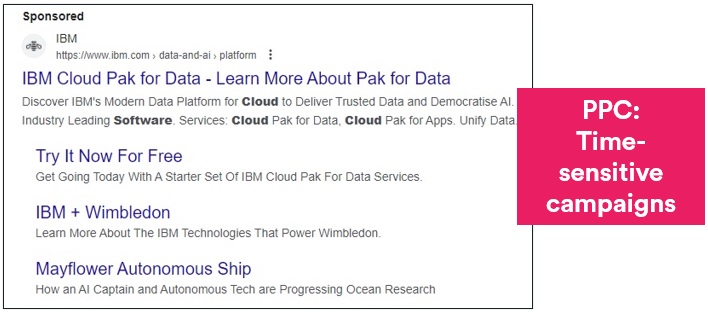
3.3 Outsmarting your competitors
Above we discussed the cost-saving potential of not bidding on your brand terms in PPC campaigns. However, we cautioned strongly against doing this if competitors are currently bidding on your brand terms.
Oftentimes competitors don’t actually bid on each other as there are risks involved. For one thing, it can be very expensive to bid on a competitor, as your ad quality score would be low due to your lack of relevance to the brand term. In addition, you could ignite a “bidding war” if your competitor then decides to bid on your brand terms, pushing up CPCs for your own brand name.
However, if you’re smart with your campaign, adopting this tactic could really pay off. Two brands that clearly think this is worth it are Naked Sprout and Zoho.
Naked Sprout is an eco-friendly toilet paper company, as is Who Gives A Crap. Naked Sprout not only outranks Who Gives A Crap for their own brand name, but they also gain the upper hand by showing off how they’re more eco-friendly. Running the strapline “We Care More – By Not Wrapping Each Roll” and having /we-give-a-crap as the display URL is a clever ploy to steal customers away from Who Gives A Crap, who do currently wrap each toilet roll in paper:

Another example of cleverly using PPC campaigns to steal away a competitor’s customers is Zoho. Not only do they outrank Zendesk for their own brand name, but they use a cheeky play on words in their ad headline (“Zoho Desk”) and send users to a product comparison page that outlines all the ways in which Zoho is superior to Zendesk:
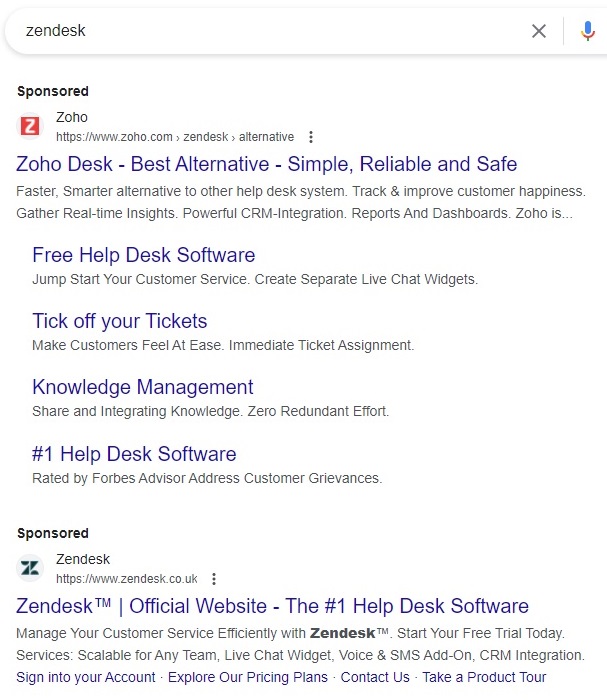
Bidding on competitor terms could therefore be an option you may also like to try, however it pays to be smart in your approach in order to make sure the potential downsides are outweighed by the benefits.
3.4 Protecting your brand’s reputation
In the same vein, PPC ads can also be used for reputation management. However, this tactic needs to be executed with care. An example of this done badly is from 2010 when BP tripled their ad spend to minimise the negative impact the Gulf of Mexico oil spill was having on their reputation.
PPC ads were utilised as part of this campaign. By bidding on keywords such as ‘oil spill’ and ‘gulf of mexico’ and then sending users to a page to show how they were trying to clean up the spill, BP were trying to improve brand perception. However, this only made things worse, with BP being accused of spending more money on ‘polishing the corporate image’ than on helping Gulf Coast states recover (source).

A better, and more subtle, way of using PPC ads to project a positive brand image is to actually do good and then call this out in your ad copy or sitelink extensions. Both the IBM and the Who Gives A Crap ad examples above do this well, with IBM highlighting how they’re progressing ocean research in one of their sitelinks, while Who Gives A Crap mention in their ad copy that they donate 50% of their profits to good causes.
Conclusion
So as we’ve explored, SEO and PPC really do work better together. In order to maximise results from search – whether organic or paid – it’s key that both channels support each other in working towards a shared goal so that your ultimate goal, more revenue and profit, can be reached. Always remember that the best approach for your business will be unique to you and if you need help establishing that, we’re here to help.